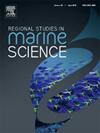The abundance and characteristics of microplastics in different organs of both wild and farmed milkfish (Chanos chanos) from Madura, Indonesia
IF 2.4
4区 环境科学与生态学
Q3 ECOLOGY
引用次数: 0
Abstract
Microplastics (MPs), represent a significant global issue that endangers aquatic ecosystems. This study aims to analyze the abundance, physical characteristics (shape, color, and size), and types of polymers and chemical compounds in gills, stomach and intestines of milkfish from marine waters and ponds from Madura Indonesia. The Kruskal-Wallis test showed that MPs in milkfish gills and water from all of the locations were not statistically different, but MPs in the stomach and intestine differed. The Mann-Whitney test showed that milkfish from Camplong pond (PCM) had the most MPs in the stomach and intestine, while milkfish from Jrengik (PJM) pond and Camplong coastal water (CWM) had no significant difference. The fiber-shape MPs were the most abundant in all organs of milkfish and water. The black MPs were the most prevalent among all milkfish organs. The MPs measuring less than 500 µm were most abundant in milkfish organs and water across all locations. The increase in MPs abundance in aquatic environments was associated with higher concentrations of MPs in organs. The Spearman correlation test revealed no correlation between the abundance of MPs in milkfish organs and the length of milkfish across all locations. Seven MPs polymers were identified in various organs of milkfish and water: polyvinyl chloride, polystyrene, polyamide, polymethyl methacrylate, polyethylene terephthalate, polyethylene, and ethylene-vinyl acetate. The analysis of the gills, stomach and intestines of milkfish using gas chromatography-mass spectrometry identified the presence of plasticizers, stabilizers, lubricants, release agents, and various additives, such as octadecanoic acid, 1-hexadecanol, oleic acid, eicosane, and hexadecanoic acid.
印度尼西亚马杜拉野生和养殖遮目鱼(Chanos Chanos)不同器官中微塑料的丰度和特征
微塑料(MPs)是危害水生生态系统的重大全球性问题。本研究旨在分析印尼马杜拉海域和池塘遮目鱼鳃、胃和肠中聚合物和化合物的丰度、物理特征(形状、颜色和大小)和类型。Kruskal-Wallis试验表明遮目鱼鳃和所有地点的水中的MPs在统计上没有差异,但胃和肠中的MPs存在差异。Mann-Whitney试验结果显示,康龙塘遮目鱼(PCM)的胃和肠道MPs含量最高,而Jrengik塘遮目鱼(PJM)和康龙塘沿岸水域遮目鱼(CWM)的胃和肠道MPs含量差异不显著。纤维状MPs在遮目鱼和水的所有器官中含量最多。黑色MPs在遮目鱼的所有器官中最为普遍。小于500 µm的MPs在遮目鱼器官和所有地点的水中含量最多。水生环境中MPs丰度的增加与器官中MPs浓度的升高有关。斯皮尔曼相关测试显示遮目鱼器官中MPs的丰度与遮目鱼在所有地点的长度之间没有相关性。在遮目鱼和水的不同器官中鉴定出七种MPs聚合物:聚氯乙烯、聚苯乙烯、聚酰胺、聚甲基丙烯酸甲酯、聚对苯二甲酸乙二醇酯、聚乙烯和乙烯-醋酸乙烯酯。利用气相色谱-质谱联用技术对目鱼的鳃、胃和肠进行分析,鉴定出增塑剂、稳定剂、润滑剂、脱模剂和各种添加剂的存在,如十八烷酸、1-十六烷醇、油酸、二十烷和十六烷酸。
本文章由计算机程序翻译,如有差异,请以英文原文为准。
求助全文
约1分钟内获得全文
求助全文
来源期刊

Regional Studies in Marine Science
Agricultural and Biological Sciences-Ecology, Evolution, Behavior and Systematics
CiteScore
3.90
自引率
4.80%
发文量
336
审稿时长
69 days
期刊介绍:
REGIONAL STUDIES IN MARINE SCIENCE will publish scientifically sound papers on regional aspects of maritime and marine resources in estuaries, coastal zones, continental shelf, the seas and oceans.
 求助内容:
求助内容: 应助结果提醒方式:
应助结果提醒方式:


